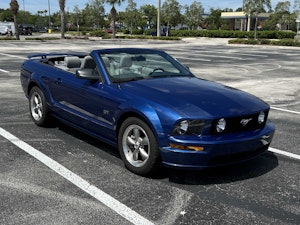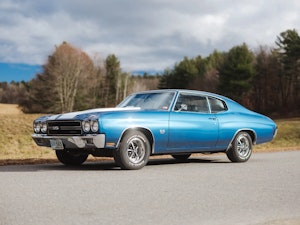Media | Articles
1959 Dodge Coronet: Wild, crazy, and totally awesome!

The 1959 Dodge was polarizing, to say the least. Chrome, with extra chrome on top of chrome. So over the top, even for 1959. Still, I love the 1959 Dodge. It’s a rare bird too, as I’ve only ever seen three of these beauties in person. One of them was a two-door Lancer hardtop, like the one my mother bought in 1969 as her first car. Her car, finished in two-tone pinkish beige and copper, was loaded: power steering, power brakes, power windows, push button Torqueflite, and the deluxe “roulette wheel” covers. But first, a little background on what is arguably the wildest Dodge ever built.
The 1959 Dodge was basically the 1957 model with heavy makeup. The “100 Million Dollar Look” of 1955–56 gave way to the dart-like “Suddenly it’s 1960” finmobiles. The 1957 “Swept-Wing” Dodge had a large bumper grille that resembled a biplane and fins that appeared to be resting on top of the quarter panel. Thanks to varying state laws, these cars had dual “headlamps”—the inboard pair of lights up front were actually turn signal/parking lamps and not high-beams.
The 1958 Dodge was much the same, but now sported a more conventional grille and quad headlights, along with some reshuffled chrome trim. I rather prefer it over the 1957, which looked kind of front-heavy with its large chrome grille bar. The 1959 restyle would be much more extensive.
The ’59 Dodge looked an awful lot like the 1957–58 version, but was actually longer, lower, and wider. It was basically an exaggeration—to an almost cartoon-like degree—of the 1957–58 styling cues. There was lots more chrome trim, even on the entry-level Coronet. Top-of-the-line Custom Royals possibly had more chrome than a ’59 Cadillac.
The 1959 Dodges were introduced on October 10, 1958, in three trim levels: Coronet, Royal, and Custom Royal. The station wagons were continued as a separate series.
Marketplace
Buy and sell classics with confidence
Along with new interior and exterior styling arrived the 383-cubic-inch V-8, in both D-500 (320 horsepower, with Carter four-barrel) and Super D-500 (345 hp, with twin four-barrel Carters) specifications. They were the biggest, brashest engines you could get.
And what better place to put your high-performance D-500 engine in than a swoopy two-door hardtop? As mentioned, one of these just happened to be my mom’s first car. It was a gigantic boat even in 1969, when she got it at Handler’s Auto on Harrison Street, in downtown Davenport, Iowa. The price? One hundred dollars.
Of course, at that price it wasn’t a mint-condition car, but it was in decent shape and everything worked. As befitted the top model, it had a power seat and push-button Torqueflite. Even power windows. It probably had the 255-hp Red Ram 326 V-8.
Mom’s Custom Royal was a two-tone pastel beige and metallic copper. Custom Royals came as four-door sedans, two- and four-door hardtops, and convertibles (the Custom Royal convertible was the rarest ’59 Dodge, with 984 built). Mid-level Royals offered only the sedan and hardtop body styles. There was also a base Coronet two-door club sedan.
An interesting new feature for ’59 was the Swivel-Seat option, which allowed the driver’s and front passenger’s seats to swivel out to about a 45-degree angle for easier entry and exit—probably a good idea, given the 1957–59 Mopars’ very low roofline. Mom’s car didn’t sport this novel feature; I asked.
Although Dodges were solid medium-priced cars, only 4.5 percent of them were equipped with factory air conditioning, an option priced at a whopping $468.55. Among the more popular options were the Torqueflite and Powerflite automatic transmissions ($226.90 and $189.16, respectively), power steering ($92.15), power brakes ($42.60), and two-tone paint ($18.55).

As previously noted, wagons comprised a separate series. The top-of-the-line Custom Sierra, pictured above, was equipped and trimmed much like the Custom Royals. Just 2432 six-passenger and 3437 nine-passenger Custom Sierras came off the line that year.

But back to Mom’s car. This land yacht was her first car, and naturally she was a little nervous driving it. She liked it, and it was a cool looking ride, but after a couple of mishaps she decided to stop driving for a while. The Dodge was sold to her Uncle Art, in nearby Buffalo, Iowa, who used it for many years as a work car. At some point after that it must have been sold or junked, but the details are lost to time. My mother’s next car was a 1960 Impala; now a more experienced driver, she enjoyed that car a lot more than the Custom Royal. But of course she loved her 1959 Dodge too. There’s always something special about your first set of wheels.
Fast forward to 2005. I was out of college and working at a local bank, but my brother was still in college at Northern Illinois University, in DeKalb. He had gone our friends’ home in Burr Ridge, a Chicago suburb, to help them move into their new vacation house in Tallulah Falls, Georgia. After they’d brought him back to Chicagoland, I was tasked with driving there from Rock Island to pick him up and bring him back.
I detest the toll booths on “scenic” Interstate 88, and driving it became even more of a hassle after manned toll booths were eliminated. I did not relish the idea of carrying some $50 in quarters, so on the return trip I skipped the interstate in favor of two-lane blacktop. It was lucky that I did, because we stumbled upon a small car show while passing through Rochelle, Illinois. The sight of that finny ’59 Coronet in the late afternoon sun immediately caught my eye. Holy cow, is that a ’59 Dodge?
It was not a Custom Royal Lancer hardtop, but a Coronet four-door sedan. It was still far from a poverty-spec model, however, especially with that eye-catching pink and rose two-tone paint job.

Fortunately, I had my camera in the car (this was the pre-smartphone era), and Andy also was eager to see a ’59 Dodge. You can see my 1999 Volvo S70 AWD lurking in the background of one photo. It looks like a golf cart compared to the Coronet.
The front end of this car might be its wildest feature, but in back things are far from tame. I’ll bet many 1959 Dodge owners got tired of replacing those elongated taillight lenses. They look rather susceptible to damage.
The “jukebox” instrument panels on these cars are very cool. There’s even a hidden ashtray that swivels out 180 degrees, like a secret entrance in a bookcase. And who doesn’t love those pushbutton Torqueflite controls?
Today, 1959 Dodges are seldom seen. Only 151,851 were built, which was better than the 133,953 in ’58 but a far cry from the 281,359 made in 1957. Chrysler had really shot itself in the foot with the poor quality of the all-new ’57s, and the chickens came home to roost in 1958 and ’59–which was too bad, as starting in 1958, rustproofing and other trouble areas were much improved. But the damage had been done.
The first one I ever saw was around 2001, at a show in Standish Park in Galesburg, Illinois. It was a Royal or Custom Royal two-door hardtop in black, with red fins, roof and lower sides, and matching interior. My friend had a camcorder, but unfortunately, I didn’t have my own camera with me that day. But just a few years ago I was attending the annual Maple City Cruise Night in Monmouth, Illinois, with my friend Jason Shafer, and lo and behold, there was the same car! Excellent.















































I was born in Detroit in 1955. At the time my mom’s side of the family all worked at Chrysler’s Highland Park headquarters location. That meant mom’s side of the family all drove Chryslers, Plymouths and Dodges. My dad’s side all worked at Ford Motor Company in Dearborn. You can imagine what our dinner conversations were like. We moved to Southern California in June of 1958. To make the cross country road trip, dad bought a new 58 Dodge Custom Sierra wagon. It was a red and white with black and white interior. I can actually remember being in that wagon as we headed west, I was just 3 years old and already a Gearhead! I think the 58 Dodges were the best-looking of all the Forward Look Dodges. The size of those wagon taillights were huge, and loaded with personality, actually all the Big Three’s cars had their own personalities. That was just great, although I think you had to be there at the time to really appreciate how stylish our American cars were. I grew up in the 60s as a true Chrysler fan, how could I not, that’s all my family ever owned. Then in 1966, my oldest brother bought a black 1966 Mustang, a 289, 4 speed. It was that Mustang that won me over as a Ford man, and I have been ever since. I’ve owned Fords, Mercurys, Lincolns and F-Series trucks. Today I have a 2008 black Explorer, with gray cloth interior. The 4.6 Liter V6 is the first non V8 engine I’ve ever owned. I do love it, and plan to keep it for many years to come. It runs great, it’s very comfortable and I think it’s very good looking. The 2006 to 2011 Explorers are the last ones with true traditional American looks, after that, like every other car, they all try to look too sofistcated. Through it all I still have strong strong feelings for our original Chrysler Corporation, Chrysler has introduced many engineering firsts that have become industry standards used all over the world. With it’s several brushes with death, I’m glad Chrysler is still one of the US Big Three, even though they are owned by Stalantis a European Corporation, they are still Chrysler.
In 1959 my wonderful grandfather wanted to buy a new car and asked me, his 15 year old grandson to pick one out for him! I chose a 1959 Dodge, solid RED, covered in chrome! It was a great choice and I’ll never forget the
“red dodge” I began driving as my first car. Even thought it was actually my grandfather’s car he gave me relative free access to use it.
Now at 78 I still have a picture of that car in a frame on my desk.